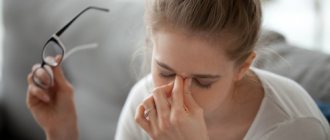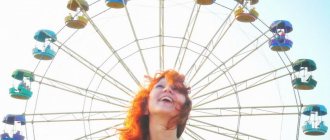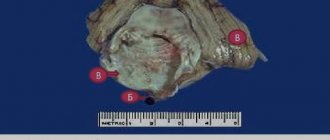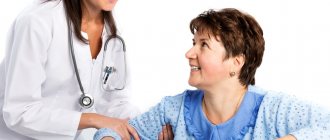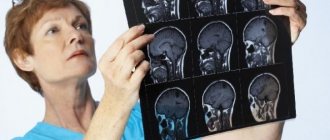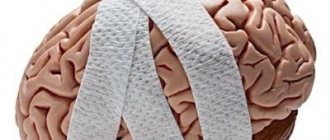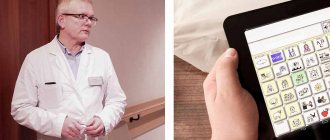body .attr-article__date{ background: none; padding: 0; }
NEAD EAD SEAD South Administrative District South-Western Administrative District CJSC Central Administrative District SZAO Northern Administrative District 01 02 03 05 06 07 08 09 1 0 1 1 1 2 14 18 15 16 17 Babushkinskaya Prospekt Mira Pervomaiskaya Baumanskaya Paveletskaya Teply Stan Shipilovskaya Prague Academic University Barrikadnaya River Station Oktyabrskoye Bratislava Taganskaya Academician Yangelya October Field
The call center is open 24 hours a day
Ambulance 24/7
Date of publication: 04/19/2017
until October 31
We're giving away RUR 1,000 for all services per visit in October More details All promotions
Symptoms of a concussion
A concussion occurs when an external impact or force causes a sudden movement of the head. In this case, the brain is displaced inside the skull, and brain tissue “impacts” against its walls, which leads to the development of concussion symptoms.
The most common symptoms of a concussion
:
- headache;
- dizziness;
- nausea;
- confusion;
- deterioration of concentration and memory;
- memory loss;
- irritability, personality changes;
- increased sensitivity to light and sounds;
- sleep disturbance;
- decreased mood;
- disturbances of smell and taste.
A concussion is not always accompanied by loss of consciousness!
Only less than 10% of people lose consciousness with a concussion.
You don't have to hit your head!
Damage to other parts of the body, as well as sudden acceleration or deceleration of movement, can also lead to a concussion.
All cases of concussions require seeking medical help!
Recommendations for a speedy recovery
Complete rest is the key to recovery.
Avoid any mental or physical activity that may make your condition worse.
Avoid physical overexertion, which can worsen symptoms
:
- Sport
- Any vigorous activity
Limit mental stress or activities that involve high concentration as this may worsen your condition:
- video games
- watching TV
- reading
- correspondence
- using a computer
- school lessons
Do not take medications containing ibuprofen or aspirin for headaches caused by concussions.
because these drugs may increase the risk of bleeding. Acetaminophen-based medications can be used.
Do not resume sports activities
before your doctor allows you to do so.
Make an appointment Do not self-medicate. Contact our specialists who will correctly diagnose and prescribe treatment.
Make an appointment
Brain concussion
Vomit
3085 05 August
IMPORTANT!
The information in this section cannot be used for self-diagnosis and self-treatment.
In case of pain or other exacerbation of the disease, diagnostic tests should be prescribed only by the attending physician. To make a diagnosis and properly prescribe treatment, you should contact your doctor. Concussion: causes, symptoms, diagnosis and treatment methods.
Definition
A concussion is a functionally reversible form of closed craniocerebral injury without organic damage to the brain, resulting from a bruise, blow, and in rare cases as a result of a sudden movement of the head.
Causes of concussion
A concussion can result from a traffic accident, a fall, domestic, sports and work-related injuries, as well as injuries received as a result of street fights and collisions during public events, or exposure to a blast wave. Even a seemingly minor head injury can lead to a concussion. Thus, the fact of an injury may already indicate a possible concussion.
The mechanism of concussion is not precisely known. Most likely, the injury causes some problems with the functioning of the brain's nerve cells (neurons). It is assumed that there is a functional disconnection between the brain stem and hemispheres of the brain. It is believed that due to concussion, a temporary disruption of interneuronal connections occurs. A slight displacement of the layers of brain tissue may appear, their nutrition may deteriorate and the connection between some brain centers may be disrupted, which contributes to the development of functional disorders. In this case, macroscopic and histological changes in brain tissue are not detected.
Among all brain injuries, concussion ranks first in frequency. In most patients, recovery occurs within 1-2 weeks.
If the patient's condition continues to deteriorate over time, and more severe forms of traumatic brain injury have been ruled out, then it is necessary to look for other causes of the existing symptoms - psychological problems, mental illness, side effects of medications or other concomitant diseases.
Classification of the disease
According to the International Classification of Diseases (ICD-10), concussion is coded S06.0. This nosology is one of the clinical forms of traumatic brain injury.
Depending on the severity of the patient’s condition and clinical symptoms, three degrees of concussion are distinguished.
Mild concussion. The victim does not have any impairment of consciousness, but disorientation, headache, dizziness, and nausea may occur during the first 20 minutes after the injury. Then general health returns to normal. A short-term increase in body temperature (37.1-38°C) is possible.
Moderate concussion. Although the victim does not lose consciousness, pathological symptoms such as headache, nausea, dizziness, and disorientation may be observed. All of them last more than twenty minutes. Short-term memory loss (amnesia) may occur, most often retrograde amnesia with the loss of several minutes of memories preceding the injury.
Severe concussion. It is necessarily accompanied by loss of consciousness for a short period of time, usually from several minutes to several hours. The victim does not remember what happened - retrograde amnesia develops. Pathological symptoms bother a person for 1-2 weeks after the injury (headache, dizziness, nausea, fatigue, disorientation, loss of appetite and sleep).
Symptoms of a concussion
Physical (somatic) symptoms:
- dizziness at rest, which intensifies when changing body position, turning or tilting the head - this is explained by impaired blood circulation in the vestibular apparatus;
- throbbing headache;
- nausea;
- one-time vomiting;
- rapid breathing, tachycardia;
- blurred vision or double vision;
- flashing of flies or stars before the eyes;
- imbalance;
- increased sensitivity to light or noise;
- ringing, noise in the ears.
Behavioral, emotional symptoms:
- drowsiness;
- increased fatigue or general weakness;
- irritability;
- depression;
- anxiety;
- excessive hours of sleep;
- difficulty falling asleep.
Cognitive symptoms:
- lethargy and impaired coordination of movements;
- short-term confusion;
- slow, incoherent speech;
- difficulty concentrating;
- difficulties remembering.
Diagnosis of a concussion
The diagnosis of a concussion is established on the basis of anamnesis, examination and the exclusion of more severe traumatic brain injury.
The doctor examines the patient's entire body for abrasions, bruises, joint deformities, changes in the shape of the chest and abdomen, and bleeding.
In the first hours after a concussion, the victim’s pupils are dilated or constricted - a traumatic brain injury of any severity leads to disruption of the nerve pathways responsible for the functioning of the eyes. The reaction of the pupils to light is normal. The victim complains of pain when moving the eyes to the sides; fine horizontal nystagmus (involuntary trembling movements of the eyeballs) is observed if the eyes are moved to the most extreme positions. Slight asymmetry of tendon reflexes and unsteadiness in the Romberg position (legs together, straight arms extended forward to a horizontal level, eyes closed) may be detected. The level of consciousness is assessed using the Glasgow Coma Scale and is 14-15 points.
The list of laboratory tests includes:
- general blood analysis;
Classification of pathology
The disease occurs in three degrees of severity, which are divided into:
- Mild form - passes without short-term loss of consciousness. The patient experiences spatial disorientation, cephalalgia, dizziness, and nausea. Symptoms are recorded within 20 minutes after the injury and can be supplemented by an increase in temperature up to 38 degrees. Subsequently, the signs of pathology spontaneously disappear and the condition stabilizes.
- Moderate – the injury does not cause fainting and manifests itself with a standard clinical picture. Unlike a mild concussion, symptoms last more than 20 minutes, and the disease can provoke short-term memory loss. Retrograde amnesia is characterized by the absence of events that occurred a few minutes before the TBI.
- Severe – manifested by short-term fainting. Events are erased from memory under the influence of retrograde amnesia, clinical signs of a concussion persist for several weeks. The condition is accompanied by sleep and appetite disturbances, nausea, problems with orientation in space, cephalgia, and fatigue.
Symptoms
What are the symptoms of a concussion in a child and an adult? The most certain is the presence of any head injury. After all, even a small bruise can lead to SGM.
Symptoms of a concussion in adults can typically include the following:
- Confusion for a short period of time.
- Dizziness. Moreover, it is observed in a state of rest. If a person changes his body position, turns, tilts his head, it intensifies. The reason for this is a violation of blood circulation in the vestibular apparatus.
- Throbbing headaches.
- Weakness.
- Noises in the ears.
- Nausea. There may be one-time vomiting.
- Confusion, slow movement, incoherent or slow speech.
- Double vision in the eyes - diplopia. If the patient tries to read, he experiences eye pain.
- Photophobia. Moreover, a painful reaction is possible even to a normal level of illumination.
- Increased sensitivity to noise. The patient is irritated even by familiar sounds.
- Impaired movement coordination.
As for the latter, it's fairly easy to install. Ask the person with their eyes closed to touch the tip of their index finger to the tip of their nose. Another option for testing coordination is to walk in a straight line, placing one foot in front of the other. Then spread your arms to the sides, close your eyes and try to take several small steps along the same line.
First aid
Let's look at the main measures of primary medical care for a concussion:
- If the victim has lost consciousness, it is necessary to call an ambulance as quickly as possible. First, lay it on a hard, flat surface on the right block, bend your elbows and knees. Tilt the person's head up a little, then turn his face to the ground - this will allow air to flow better through his respiratory tract. This also prevents aspiration - the penetration of foreign objects and substances.
- If the victim is bleeding, a hemostatic bandage should be applied to the wound.
- If a person wakes up, or fainting does not happen to him, he should be laid horizontally and a soft object placed under his head so that it is slightly elevated. Make sure that he is conscious - do not let the victim fall asleep until doctors arrive.
- All people with a head injury should be examined at an emergency room. By decision of a specialist, they may subsequently be sent for outpatient therapy to a neurologist. In severe cases, the victim is hospitalized in the neurological department for diagnosis, monitoring of his condition, and treatment.
- If a person is unconscious, and you are not able to independently determine the severity and nature of the injuries, do not try to move him, move him, or turn him over. Just make sure that nothing restricts his body, nothing interferes with free breathing. If necessary, remove liquids (for example, vomit), loose substances or any small objects from the respiratory tract.
Medical diagnosis
But with SGM one cannot do without professional methods for diagnosing the patient’s condition:
- MRI for concussion.
- X-ray of the skull and cervical spine.
- Encephalography.
- CT scan.
- Echoencephaloscopy.
- Taking a spinal tap.
- Fundus examinations.
Pathogenesis
Normally, the human brain is located in the cerebrospinal fluid. When you shake your head sharply, a hydraulic shock occurs, triggered by a pressure difference in the cerebrospinal fluid. Sometimes the brain can hit the inside of the skull.
With injuries and contusions, a concussion of the entire brain tissue occurs. At the very beginning, there is a diffuse dysfunction of the brain ( fainting ). After a couple of minutes or hours, the severity of general phenomena decreases, and only signs of focal disorders remain in a certain area of the brain.
Symptoms of trauma develop due to the development of functional disconnection of the brain stem and hemispheres. When a shock occurs, some of the physical and chemical properties of neurons change, which can lead to changes in the spatial organization of protein molecules. It is also likely that there is a temporary disconnection of signals between the synapses of neuron cells and parts of the brain. A synapse transmits nerve impulses between cells. This is the site of contact between neurons or between a neuron and the effector cell that receives the signal. And if the relationship is temporarily disconnected, functional disorders develop. During a concussion, the entire substance of the brain is affected pathologically.
More sensitive techniques
It should be noted that patients who have suffered mild brain injuries have many complaints about their condition, in particular with regard to memory problems. These complaints do not always correspond to the results of neuropsychological examinations or brain scans using neuroimaging methods. The presence of some factors that influence recovery after injury cannot be ruled out. This may be pre-existing problems with processing information. Therefore, it is very important to involve the patient’s family in the recovery process. “At the same time, it is difficult to predict in advance the outcome of restoration in each specific case.” Currently, more and more sensitive methods for determining the degree of brain damage are emerging. Thus, the University Medical Center Groningen is currently investigating the use of perfusion computed tomography, which allows the blood circulation of the brain to be recorded in the image immediately after an accident. This is achieved by adding a small amount of contrast agent. More advanced neuroimaging techniques are being developed, as well as more sensitive neuropsychological tests to identify limitations in functioning. So we will have to face many more challenges in the future, concludes Van der Naalt.
Based on materials:
Geheugenverlies na traumatisch hersenletsel. — Hersen Magazine, 2008, Vol.6, No. 2 (juni), p. 3-4.
Therapy
Of course, you shouldn’t look for pills for concussions on your own. Incorrect or insufficient treatment with BGM can lead to the following:
- Chronic imbalance.
- Mental changes.
- Chronic tremors of the limbs.
- Post-traumatic syndromes - persistence of increased fatigue, persistent memory impairment.
Therapy for SHM is prescribed in a comprehensive manner:
- Sedatives.
- Analgesics.
- Sleeping pills.
- Metabolic and vascular therapy.
- Tonics.
Treatment will not be effective if the patient does not comply with bed rest for 5-7 days. Depending on the severity of the concussion and whether the doctor’s advice is followed correctly, the patient’s condition will improve within a couple of weeks.
Treatment with folk remedies
To speed up the healing process, you can use some folk remedies.
- Infusion of mint, lemon balm and mistletoe. Take 1 tbsp. l. each of the herbs, pour into a thermos and pour 2 tbsp. boiling water Infuse overnight, drink half a glass 4 times a day.
- St. John's wort decoction. It is prepared from 2 tbsp. l. St. John's wort and 1 glass of water. The decoction should be brought to a boil, infused and drunk 100 g three times a day.
- Restoring infusion. Take 10 g of mint leaves, hop cones, buckthorn bark, lemon balm herb and 20 g of valerian root. Mix all ingredients, take 2 tbsp. l. means and fill it with 2 tbsp. boiling water Drink 100 g several times a day, be sure to take the infusion before bed.
- Soothing infusion. You need to take 2 tbsp. l. herbs mint, motherwort and lemon balm, pour 1 liter of boiling water and leave overnight. Drink half a glass three times a day.
- The infusion is soothing and restorative. It is necessary to take hop cones, buckthorn bark, lemon balm, valerian root, birch leaves, fireweed, and St. John's wort in equal proportions. Pour 3 tbsp. l. this collection with one liter of boiling water and leave for 2 hours. Drink half a glass 3 times a day.
- A remedy for insomnia. Mix 1 tbsp. l. mint herbs and 1 tsp. cinnamon. Pour boiling water (1 liter) and leave in a thermos for 2 hours. Drink 4 r. 100 g per day, also taken before bed.
- A mixture of honey and nuts. Chopped nuts should be mixed with honey in equal proportions and take 1 tbsp of this remedy. l. every day for six months.
- Bee pollen. It is recommended to take its granules - half a teaspoon per day for a month. Repeat after six months.
- It is recommended to sleep on a pillow with soothing herbs - mint, lemon balm, lovage, clover.
How to get rid of headaches?
The first step is to sign up for an MRI of the head to identify organic damage. Then undergo a course of treatment and establish self-regulation of nerve tissue metabolism. Timely medical care reduces the risk of encephalopathy, epilepsy, and asthenia. And at the same time it helps to avoid personality changes, anxiety, insomnia, and dizziness.
For mental injuries and post-traumatic cognitive disorders (memory loss, confusion, impaired thinking), it is necessary to undergo socio-psychological rehabilitation, including classes with a psychologist, speech therapist, occupational therapy to restore self-care skills, restorative physiotherapy and other procedures.
